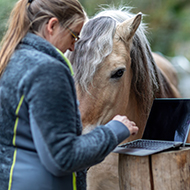Chimpanzees drum distinct rhythms, study finds
"Our ability to drum rhythmically may have existed long before we were human." - Catherine Hobaiter
A team of researchers has discovered that chimpanzees drum rhythmically, adding regular spacing between their drum hits.
The study saw cognitive scientists and evolutionary biologists examine the behaviours that eastern and western chimpanzees use to communicate with their group.
Drumming has been proven to be a common method of communication among chimpanzees. The primates produce low-frequency sounds by drumming on buttress roots, which grow above the soil.
A previous project revealed that chimpanzees each had their own unique drumming style, which they use to communicate where they are and what they are doing. The chimpanzees used percussive patterns to send information over long and short distances.
This latest project sought to discover how drumming styles changed between different chimpanzee communities, and whether they had a humanlike rhythm.
To explore this, the team worked with chimpanzees researchers to study 371 drumming bouts across 11 chimpanzee communities – including six populations and two subspecies.
The researchers analysed the drumming patterns of the chimpanzees, which revealed a distinct rhythm to the way they drummed. The timing of their hits also proved to be non-random and often evenly spaced.
The two subspecies, eastern chimpanzees and westerns chimpanzees, were also discovered to be exhibiting different drumming patterns.
While eastern chimpanzees alternated between shorter and longer time intervals between beats, western chimpanzees kept evenly spaced hits. Western chimpanzees also drummed with a faster tempo, integrating their drumming earlier in their pant-hoot vocalisations.
Catherine Hobaiter, a senior author of the study from University of St Andrews, said: “Making music is a fundamental part of what it means to be human — but we don’t know for how long we have been making music,
“Showing that chimpanzees share some of the fundamental properties of human musical rhythm in their drumming is a really exciting step in understanding when and how we evolved this skill.
“Our findings suggest that our ability to drum rhythmically may have existed long before we were human."
The full study can be found in the journal Current Biology.
Image © Shutterstock



 With Strangles Awareness Week just around the corner (5-11 May), vets are being encouraged to share a survey about the disease with their horse-owning clients.
With Strangles Awareness Week just around the corner (5-11 May), vets are being encouraged to share a survey about the disease with their horse-owning clients.